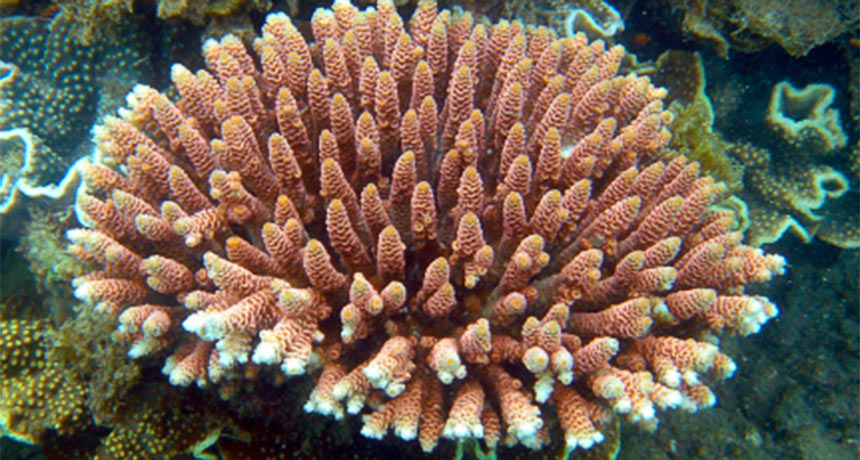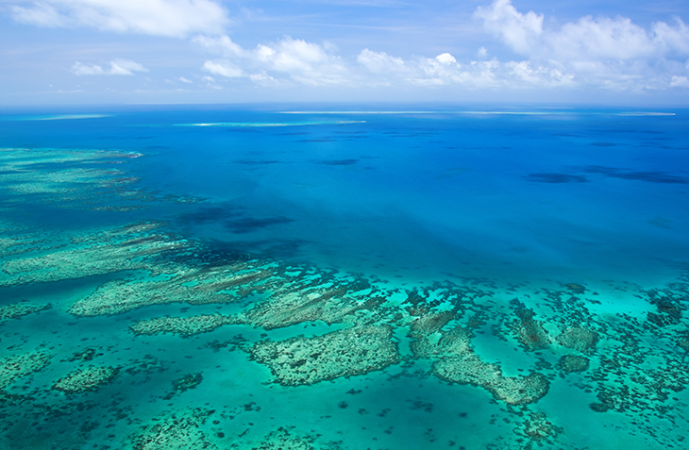Ocean heat waves are on the rise — and killing coral
But some coral species may be survivors, new research shows

Staghorn coral may be able to last 100 to 250 years thanks to its ability to adapt to warming waters, a new study shows. Here, a healthy staghorn grows off Magnetic Island in the central part of Australia’s Great Barrier Reef.
M. Matz et al/PLOS Genetics 2018
By Dan Garisto and Carolyn Gramling
The world’s oceans are sweltering. Over the last century, marine heat waves have become more common and are lasting longer. Two recent heat waves have had a devastating effect on corals in the Great Barrier Reef, off the coast of Australia. But corals might not be as doomed as scientists once thought.
A marine heat wave isn’t just any bout of hot water in the ocean. Scientists define it as lasting at least five consecutive days. The water also must be unusually warm for that ocean region or season. These temperature extremes can be killers for marine species such as corals, kelp and oysters. They also can wreak havoc on fisheries and aquaculture.
In a new study, researchers wanted to know whether the frequency of these heat waves has changed. They searched for such events in data on sea-surface temperatures dating as far back as 1900. They also looked in satellite data that have been collected since 1982.
Those data suggest that the number of days each year that some part of the ocean experiences a heat wave has increased by 54 percent between 1925 and 2016. Over that time, heat waves also have become 34 percent more common — and last about 17 percent longer. Researchers shared their new findings April 10 in Nature Communications.
That trend is mostly influenced by climate change. Excess greenhouse gases in the atmosphere have trapped heat close to Earth’s surface. That has warmed the ocean’s surface waters. The researchers were able to rule out that large atmosphere-ocean climate patterns caused this trend. Such patterns include the periodic warming and cooling of waters in the equatorial Pacific. That’s called ENSO. It’s short for the El Niño-Southern Oscillation.
In coming decades, such marine heat waves may become even more common, the researchers now suspect.
Coral devastation
It’s no secret that warming ocean waters have devastated many of the world’s coral reefs. For instance, a new study finds, a 2016 marine heat wave killed almost one-third of the coral in the Great Barrier Reef.
“What we’ve just experienced [in the Great Barrier Reef] is one hell of a natural-selection experiment,” says Terry Hughes. He’s a coral-reef expert at James Cook University in Townsville, Australia. In total, about half of the reef’s corals have died since 2016, he says. On the bright side, maybe: “The ones that are left are tougher.”
His team published its findings online April 18 in Nature.
What happens to coral reefs affects vast underwater ecosystems. It also will affect the hundreds of millions of people who depend on those ecosystems for fishing, tourism and more. So scientists want to understand how corals might fare as climate change triggers longer and stronger marine heat waves.
These heat waves can cause coral bleaching. That’s when corals eject the symbiotic algae that live with the corals. These algae are known as zooxanthellae (ZOH-zan-THEL-ay). They provide corals with both nutrients and color. If the algae don’t return, the corals eventually bleach — turn bone white — and die.
In extreme cases, marine heat waves kill corals directly. Essentially, they roast them alive. That happened to some on the Great Barrier Reef, Hughes and his colleagues found. They gathered data from satellite images and ocean surveys. It took less heat stress to kill off corals than had been expected, they showed. (Heat stress refers to how hot the water was and how long it stayed hot.)
Story continues below image.

A well-adapted species
Mikhail Matz is a biologist at the University of Texas at Austin. He and his colleagues have studied staghorn corals (Acropora millepora). These corals appear very vulnerable to marine heat waves. Still, this species may turn out to be one of the more resilient ones.
This branching, fast-growing coral is a key reef builder. And new analysis shows it is genetically diverse enough to survive for another 100 to 250 years. This is encouraging. Other studies had suggested that many coral reefs might not last another 80 years.
In fact, the corals on this reef show signs of adapting quickly enough to keep pace with warming waters. Or, at least they appear to for now, Matz’s study suggests.
In the northern part of the Great Barrier Reef, the water can be more than 5 degrees Celsius (9 degrees Fahrenheit) warmer than in the south. Yet staghorn corals live throughout the region. That means there already are members of this species with the genes to handle such heat. It appears that those in the north have become “locally adapted,” Matz explains. As the southern area warms, some of the offspring of the heat-resistant corals could migrate there.
This could let some reefs beat the heat by recruiting corals from more heat-adapted sites. These animals would not need to undergo genetic changes — mutations — to become heat resistant. And that would be fortunate. After all, developing such mutations can take a lot of time.
Matz and his colleagues reported their findings April 19 in PLOS Genetics.
If corals must move to adapt, people should help make the migration corridors that the corals must travel comfortable, says William Cheung. He’s a marine biologist at the University of British Columbia at Vancouver. He was not involved in either study. Reefs along the way might be protected, for instance, from destruction by fishers and others.
That may be prove a challenge, though. Hughes’ team has already documented widespread destruction in the Great Barrier Reef. Even so, Matz believes that “there is still time for us to act before corals actually start going extinct.”







